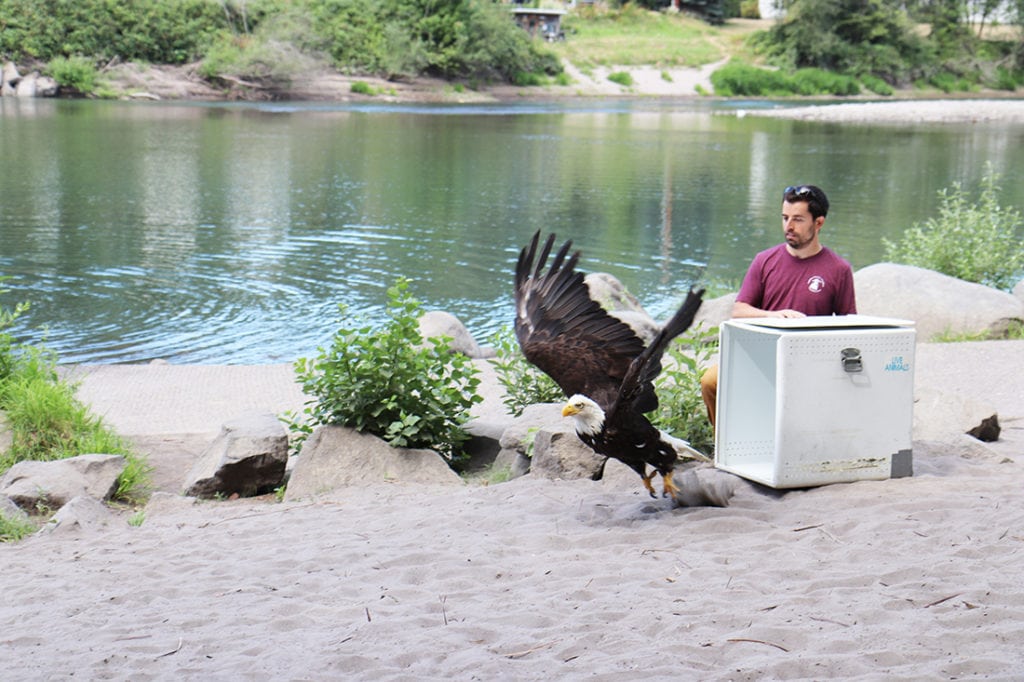
It turned out the eagle had taken an unwitting plunge into Troutdale, Oregon’s Water Pollution Control Facility lagoon where Kesty works as a waste treatment operator. That’s where the municipality stores biosolids comprised of sanitized sewage – the same milkshake-like liquified excrement and waste Kesty had just pumped into his truck. The biosolids he transports are used to fertilize hay grown for cattle ranches in the Troutdale area, he said.
His work completed, he returned to the lagoon to check on the bird, and found her waddling along. “It did try to fly, but it would only get like two feet off the ground,” he recalled. “It was so covered and caked with biosolids.”
Chances are, he explained, the eagle had attempted to capture one of the ducks or geese that are often spotted around the property when she made the fateful descent into the lagoon, perhaps mistaking the sludge for solid ground.
A true good Samaritan, Kesty contacted Bird Alliance of Oregon and the following mid-July day, a staff member trekked to Troutdale to retrieve the unfortunate eagle. When the bird arrived at our Wildlife Care Center, staff determined that she, too, had come a long way: around 300 miles from up north in Vancouver, British Columbia, Canada where she was hatched and banded in 2008.
Bald Eagles are a protected species, so they are often traceable through the federal banding reporting system which enables monitoring of information such as where they were born and when. In fact, because it is extremely difficult to determine the age of adult birds of prey, the banding system provides us with information that otherwise would be near-impossible to ascertain.
Despite having feathers matted together with dried sewage which prevented her from taking flight, the eagle showed positive signs upon intake at the Wildlife Care Center.
There, staff gave her a preliminary cleaning, using a toothbrush and wet cloth to remove dried organic debris from around her eyes and face. But the Wildlife Care Center isn’t properly equipped to clean a female Bald Eagle – they can weigh up to around 14 pounds with a wingspan of nearly seven feet. So, it was off to our partners at the nearby Oregon Zoo the next day, where the facilities are better-suited for a more thorough eagle-bathing experience. There, after taking X-rays, a veterinarian also determined the eagle had no injuries.

Safely returned to the Wildlife Care Center for rehabilitation, the eagle’s weight and food intake were closely monitored by staff and volunteers, and it wasn’t long before she showed noticeable signs of improvement. Just ten days later, after staff had determined the Bald Eagle could fly and hunt prey on her own, she was released back into the wild on the Sandy River.
Think this was the first time a Bald Eagle has landed in a sewage slurry? Surprising enough, it wasn’t even the first time this year. In January, a male Bald Eagle was rescued from a wastewater treatment plant’s oxidation ditch in Colorado.
For Troutdale’s Kesty, if anything, this was a once-in-a-lifetime event. He described the heartwarming feeling of seeing the Bald Eagle again able to soar, and concluded simply, “It’s not every day you get to help something.”
After just a few days, we were thrilled to be able to release this Bald Eagle along the Sandy River with a group of Bird Alliance of Oregon campers, who spent the week learning about birds of Portland.

Kate Kaye is a volunteer at Bird Alliance of Oregon’s Wildlife Care Center. A veteran tech and data reporter who has appeared on NPR’s On the Media, Weekend Edition Sunday and at events held by Yale Law School and Harvard’s Nieman Journalism Lab, Kate is also the author of the book, “Campaign ’08: A Turning Point for Digital Media.”
Every year the Wildlife Care Center treats 3,000 injured or orphaned native animals. If you would like to make a donation to support our wildlife rehabilitation work at the Wildlife Care Center, click here.



